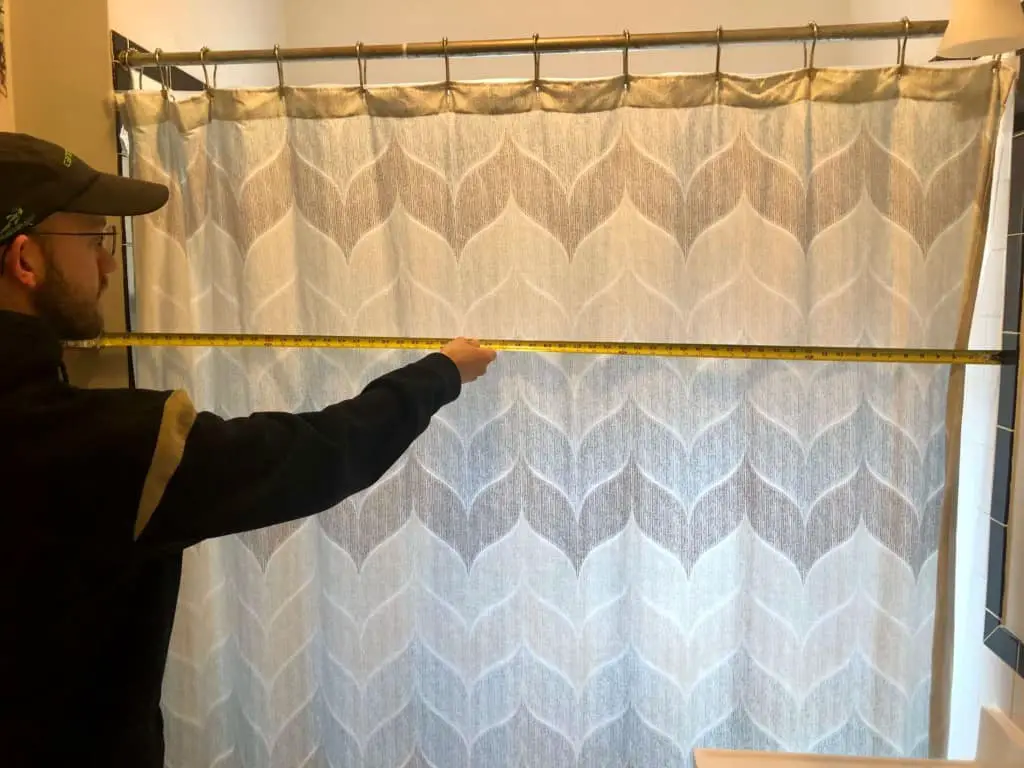
Whether you’ve just moved into a new home, or you’ve decided to give your bathroom an upgrade, getting a new shower curtain is a task that’s often overlooked. As simple as it sounds, you may find yourself asking, what shower curtain size do I need?
There are three standard shower curtain sizes: 70×70″, 70×72″, and 72×72″. One of these 3 sizes will work for the showers found in most homes. However, there are exceptions, and you may need a different size if you have an oversized shower, stall shower, or a curved curtain rod.
Now that you’ve got the brief breakdown, let’s dig into it a little more and show you how to find out which size will fit your shower.
Table of Contents
Standard Shower Curtain Sizes
There are 3 standard shower curtain sizes:
- 70 x 70 inches
- 70 x 72 inches
- 72 x 72 inches
One of these 3 sizes will work for the showers found in most homes. However, there are exceptions, and you may need a different size if you have an extra-wide shower, an extra-tall shower, a stall shower, or a curved curtain rod.
Here’s a table that has the standard shower curtain size and the most common other sizes of shower curtains to give you a quick look.
| Shower Type | Shower Curtain Measurements |
| Standard Shower | 70 x 70″, 70 x 72″, or 72 x 72″ |
| Extra Tall Shower | 72 x 84″ |
| Extra Wide Shower | 84 x 72″ |
| Stall Shower | 50 x 78″ or 54 x 78″ |
| Curved Shower Rods | 84 x 72″ |
Sound confusing? Don’t get nervous, we’re here to help. This post will guide you through easy steps for choosing the perfect size shower curtain for your bathroom. You’ll be singing in the shower in no time!
How to Measure Your Shower Curtain
There are many different sizes of shower curtains. To make sure you have the right size shower curtain to fit your shower, you’ll want to measure your shower.
1. Measure the Width
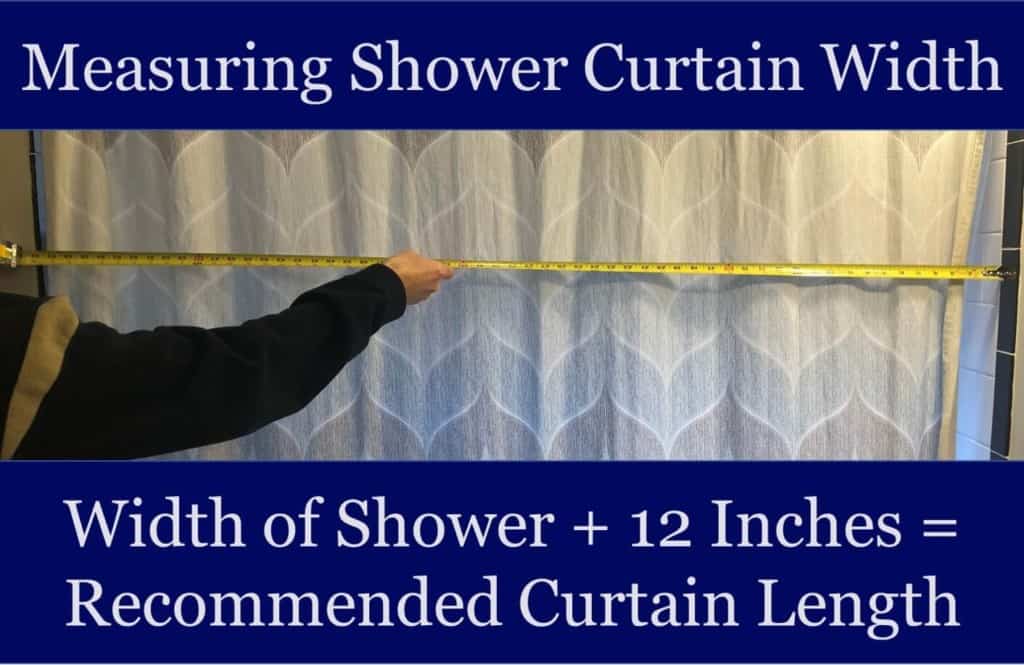
First, measure the width of your shower curtain in inches. Simply take a tape measure and measure the entire length of the shower space from wall to wall. Then, add 12 inches to the shower width to ensure the curtain will be able to move freely and still reach both walls to provide ample coverage.
Choose a curtain that fits the opening correctly. As we mentioned above, a standard shower curtain comes in 1 of 3 sizes:
- 70 x 70 inches
- 70 x 72 inches
- 72 x 72 inches
If you don’t have a standard-sized shower, don’t worry. In one of the next sections, we cover special shower curtain sizes.
2. Determine Where the Rod Will Go
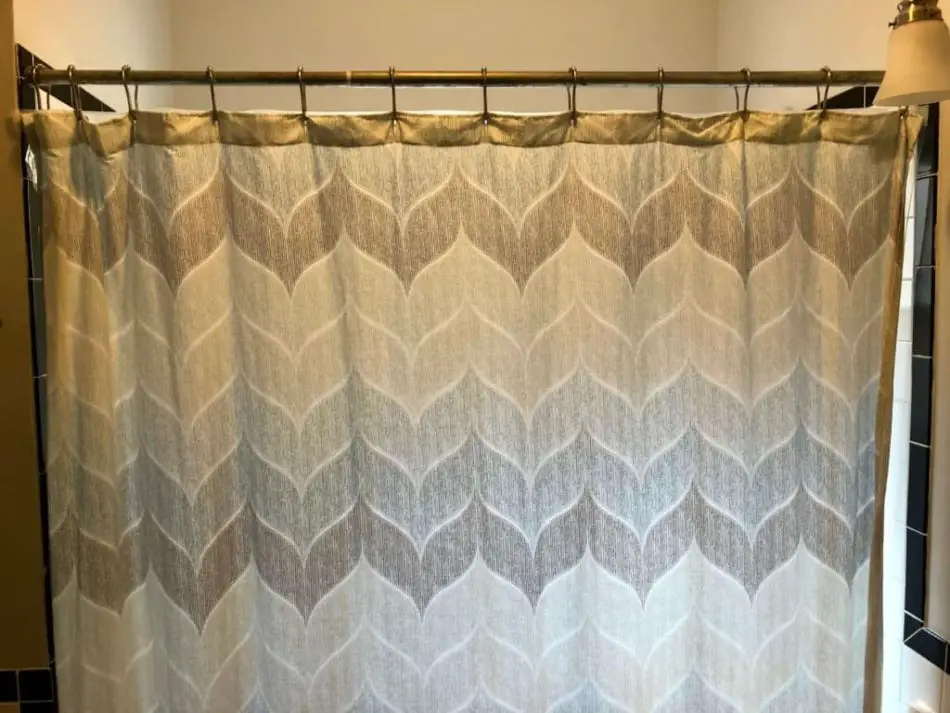
If you don’t already have the shower curtain rod installed, then you’ll need to decide exactly how you will mount it. As part of this, you’ll need to decide if you want your rod to mount on the outside or the inside of your shower.
Inside mounts fit between the opening exactly, and extend from wall to wall. Outside mounts have a bit more flexibility and can extend outside the actual opening.
If you are using a shower rod that mounts permanently to the wall, always buy your shower curtain before mounting your rod, in case any adjustments need to be made to your measurements.
Sometimes, it’s helpful to use a spring-rod temporarily, to hold the place of the actual curtain rod, just so you are able to measure correctly. Once you have the details for the rod worked out, you’ll need to get the curtain height.
3. Measure the Height
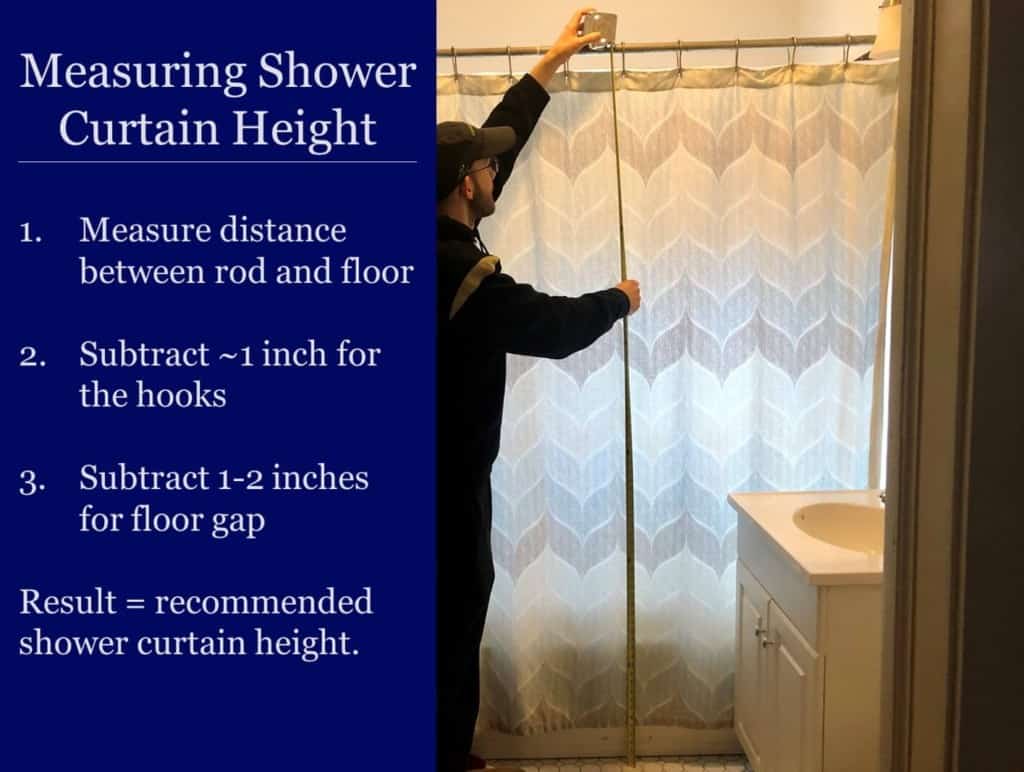
Next, determine how high off the floor you would like your curtain to hang. Ideally, you will want to hang your shower curtain so the bottom is just 1 to 2 inches off the floor.
While there is no actual rule, hanging your curtain too high will allow water to escape and pool on the floor. Hanging it too low will cause it to bunch on the bathroom floor and create mold or worse you could trip over it while getting in or out of the shower.
Using the tape measure, measure the distance from where the rod will go, to the floor. Subtract an inch or so for the curtain rings and 1-2 inches for the space between the curtain and the floor.
And there you have it!
Now you have all the measurements. Keep in mind that a standard shower curtain height is usually 70 or 72″ and the standard shower curtain width is usually 70 or 72″. They are designed to fit 60-inch standard tubs with 12 inches of extra fabric to guarantee total coverage.
If your shower and rod are standard size then you are good to go. However, not all showers are created equally. If your shower curtain size measured up to something not standard, then read on. The next section covers non-standard shower curtain sizes.
Special Shower Curtain Sizes
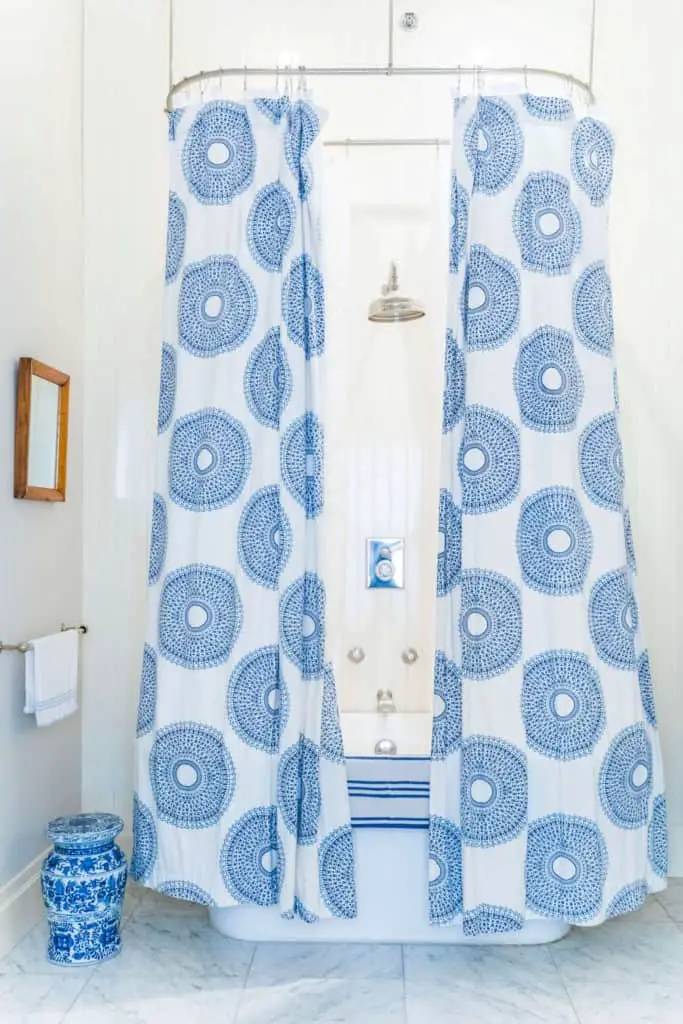
Extra Tall Showers
If you have high ceilings in your bathroom, you may need an extra-long shower curtain. Extra tall shower curtains usually measure 72 x 84″.
You may also need an extra tall shower curtain if you have a stall shower, we’ll talk about that below.
Although tall showers are not a standard size, there are still many options that supply strange shower sizes.
Extra Wide Showers
Although most houses and apartments have standard-size showers and tubs, they do come in a variety of sizes. An extra wide shower will typically measure 84 x 72″.
The good news is, if your shower is larger than the typical 60-inch tub, you can buy some designer shower curtains with a width of up to 108 inches.
Another option would be to buy two shower curtains and hang them together. Depending on the actual size of the shower, you would have to be careful with this option because you may have over 12 inches of curtain left over. In this case, tiebacks might be a good idea.
Stall Showers
If you happen to have a stall shower instead of a full-size tub, the standard measurements and way of measuring are going to be a bit different. Stall showers are taller and skinnier than standard showers.
Stall shower curtains are typically shorter in width but longer in length than a standard shower curtain. They are available in a standard size of 50 x 78 and 54 x 78.
Measuring the width of the stall is the same as measuring a standard tub. Using the measuring tape, measure from one side to the other and add the additional 12 inches to allow for curtain movement.
For the height, remember to make sure the curtain falls long enough to prevent water from spilling out onto the floor but not too long that it is dragging. It should only reach the curb of the shower, allowing it to direct the water inside, but not posing a hazard.
Curved Curtain Rods
If this is the style rod that you have, measure the entire shape of the rod. Generally, these will measure about 6 inches longer than a standard shower curtain rod. While you can still use the standard 72-inch curtain, you will only have about six inches of free-moving fabric.
Although this will still provide adequate coverage, your best bet in this situation is to get an extra wide shower curtain. So, one that measures 84 x 72″.
You may have to order one, but it will be worth the wait, rather than sacrificing the extra inches.
Why That Curtain is So Important
The most important thing to remember is, that although your bathroom is most likely the smallest room in the house, it’s likely that it serves the biggest purpose. Your shower curtain is not just a small sideshow added to the decoration of your bathroom, it is pretty much the main attraction.
Not only does the shower curtain serve as an important element of design, but it also serves a practical purpose, protecting your floors from water damage and you and your guests from slips and falls.
When choosing what size shower curtain you need, you must choose the perfect size for your shower. A curtain that is too small will leave you constantly adjusting, and cold.
A curtain that is too big will have you constantly fighting the extra length from things like bunching and getting wet, and probably cause a serious mold and mildew issue.
That being said, you must take the time to measure your space correctly to ensure that you buy a curtain that fits just right rather than just guessing what size you will need. In the long run, it will save you a lot of time, energy, and money. Now, go hang that curtain.
Types of Shower Curtains
Vinyl Shower Curtains
Vinyl curtains are the most common material. It is usually made of polyethylene vinyl acetate or PEVA. PEVA is a safe alternative to PVC which used to be used in nearly all shower curtains and liners.
You should avoid any shower curtains that are made with PVC because in recent years it has been found to have a negative health impact.
But, PEVA curtains give all the benefits of PVC without any of the nastiness. This type of shower curtain is completely waterproof and very cheap.
If using plastic curtains still sounds like a bad idea to you, check out our post that has The 11 Best Non-Toxic Shower Curtains and Liners.
Natural Fabric Curtains
Natural fabric shower curtains are becoming more common. They are more eco-friendly and nontoxic, and they can add a nice design element to your bathroom.
Common natural materials are cotton shower curtains, hemp shower curtains, and linen shower curtains. Which one you choose will vary on your personal preference and your bathroom decor.
Shower Curtain Alternatives
If you want more of a decorative shower curtain or if you want to get rid of the shower curtain altogether, you might look into shower curtain alternatives.
There are a ton of alternatives to vinyl or plastic shower curtains including shower doors, shower screens, and using a room divider.
Here is a list of all the best alternatives: hemp, cotton, linen, shower bling, sliding door, pivot door, half screen, open shower, macrame curtain, room divider, bamboo panels, frameless partition, window framed shower, frosted glass partition, glass block partition.
For information about all of these options, check out our other post here.
Related Questions
Should the Shower Curtain and Liner be the Same Size?
The average shower curtain liner measures 70 inches wide and 72 inches long, which is basically the same size as most shower curtains. Ideally, your shower curtain liner should hang approximately 5 to 6 inches longer than the top of your tub. Shower curtain liners are also available in special sizes. For example, a stall shower liner measures 54 x 78. Here’s our other post that breaks down shower curtains vs liners.
Does the Shower Curtain Go Inside the Tub?
The shower curtain liner should always go inside the tub or shower base. Shower curtain liners are usually made of vinyl or plastic and are designed to prevent the water from leaking out of the shower. The liner is used primarily for practical purposes whereas the curtain is usually used for decoration and privacy.
How to Hang a Shower Curtain Rod
The simplest way to secure a shower curtain rod is to purchase a tension rod, here’s our post about different types of shower curtain rods. Put the rod through the curtain holes first, then make sure the rod is straight against both sides of the wall. Twist it firmly into place and use the locking mechanism to hold it there. You can also use adhesive mounts or, with some expertise, drill mounts into the wall.
